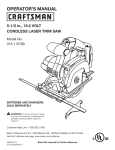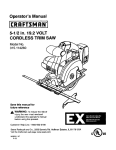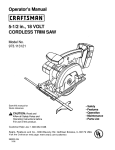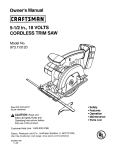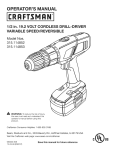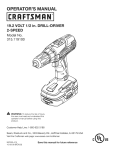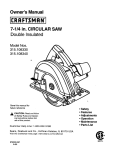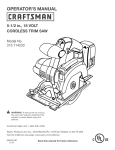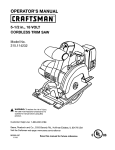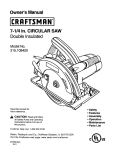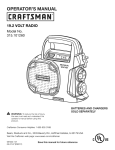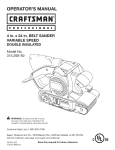Download Craftsman 315.114261 Operator`s manual
Transcript
perator's nual T 5-1/2 in, 19.2 VOLT CORDLESS TRiM SAW Model No. 315.114261 ® _ BATTERIES AND CHARGERS SOLD SEPARATELY WARNING: To reduce the risk of injury, the user must read and understand the operator's manual before using this product. Customer Help Line: 1-800-932-3188 Sears Roebuck and Co., 3333 Beverly Rd. Hoffman Estates, Visit the Craftsman web page: www.sears.com/craftsman 983000-91 5 03-26-08 (REV:02) Save this manual IL 60179 USA for future reference C US [] Warranty ........................................................................................................................................................................... 2 [] Introduction 2 ...................................................................................................................................................................... [] General Safety Rules ..................................................................................................................................................... 3-4 [] Specific Safety Rules ..................................................................................................................................................... 4-5 [] Symbols ......................................................................................................................................................................... 6-7 [] Features ......................................................................................................................................................................... 8-9 [] Assembly ..................................................................................................................................................................... 9-11 [] Operation ................................................................................................................................................................... 12-19 [] Maintenance .............................................................................................................................................................. 20-21 [] Accessories .................................................................................................................................................................... 21 [] Exploded View and Repair Parts List ........................................................................................................................ 22-23 [] Parts Ordering / Service .................................................................................................................................... ONE YEAR FULL WARRANTY ON CRAFTSMAN Back page TOOL If this Craftsman tool fails to give complete satisfaction within one year from date of purchase, RETURN IT TO THE NEAREST SEARS STORE OR SEARS PARTS & REPAIR CENTER IN THE UNITED STATES, and Sears will repair it, free of charge. If this Craftsman tool is used for commercial or rental purposes, this warranty applies for only 90 days from the date of purchase. This warranty gives you specific legal rights, and you may also have other rights which vary from state to state. SEARS, ROEBUCK AND CO., DEPT. 817WA, HOFFMAN ESTATES, IL 60179 This tool has many features for making its use more pleasant and enjoyable. Safety, performance, and dependability have been given top priority in the design of this product making it easy to maintain and operate. WARNING: Some dust created by power sanding, sawing, grinding, drilling, and other construction activities contains chemicals known to cause cancer, birth defects or other reproductive harm. Some examples of these chemicals are: • lead from lead-based paints, • crystalline silica from bricks and cement and other masonry products, and • arsenic and chromium from chemically-treated lumber. Your risk from these exposures varies, depending on how often you do this type of work. To reduce your exposure to these chemicals: work in a well ventilated area, and work with approved safety equipment, such as those dust masks that are specially designed to filter out microscopic particles. _ WARNING!READ STRUCTIONS. AND UNDERSTAND ALL IN- Failure to follow all instructions listed below, may result in electric shock, fire and/or serious personal injury. SAVE THESE WORK iNSTRUCTiONS AREA [] Keep your work area clean and well lit. Cluttered benches and dark areas invite accidents. [] Do not operate power tools in explosive atmospheres, such as in the presence of flammable liquids, gases, or dust. Power tools create sparks which may ignite the dust or fumes. [] Keep bystanders, children, and visitors away while operating a power tool. Distractions can cause you to lose control. ELECTRICAL SAFETY [] A battery operated tool with integral batteries or a separate battery pack must be recharged only with the specified charger for the battery. A charger that may be suitable for one type of battery may create a risk of fire when used with another battery. [] Use battery operated tool only with specifically designated battery pack. Use of any other batteries may create a risk of fire. [] Use battery MODEL only with charger BATTERY PACK (M-ion) 315.113740 (130285003) 315.114261 BATTERY PACK (Ni-Cd) 130279003, 130279005 (Item No. 911375) listed. CHARGER (Multi-Chemistry) 315.259260 (140351001) 315.259260 (140351001) 1425301 &11041) 315.115730 (140301003) 315.115720 (140301001) PERSONAL SAFETY [] Stay alert, watch what you are doing and use common sense when operating a power tool. Do not use tool while tired or under the influence of drugs, alcohol, or medication. A moment of inattention while operating power tools may result in serious personal injury. [] Dress properly. Do not wear loose clothing or jewelry. Contain long hair. Keep your hair, cJothing, and gloves away from moving parts. Loose clothes, jewelry, or long hair can be caught in moving parts. [] Avoid accidental starting. Be sure switch is in the locked or off position before inserting battery pack. Carrying tools with your finger on the switch or inserting the battery pack into a tool with the switch on invites accidents. [] Remove adjusting keys or wrenches before turning the tool on. A wrench or a key that is left attached to a rotating part of the tool may result in personal injury. [] Do not overreach. Keep proper footing and balance at all times. Proper footing and balance enable better control of the tool in unexpected situations. [] Use safety equipment. Always wear eye protection. Dust mask, non-skid safety shoes, hard hat, or hearing protection must be used for appropriate conditions. [] Do not wear loose clothing or jewelry. Contain long hair. Loose clothes, jewelry, or long hair can be drawn into air vents. [] Do not use on a ladder or unstable support. Stable footing on a solid surface enables better control of the tool in unexpected situations. TOOL USE AND CARE [] Use clamps or other practical way to secure and support the workpiece to a stable platform. Holding the work by hand or against your body is unstable and may lead to loss of control. [] Do not force tool Use the correct tool for your application. The correct tool will do the job better and safer at the rate for which it is designed. [] Do not use tool if switch does not turn it on or off. A tool that cannot be controlled with the switch is dangerous and must be repaired. [] Disconnect battery pack from tool or place the switch in the locked or off position before making any adjustments, changing accessories, or storing the tool Such preventive safety measures reduce the risk of starting the tool accidentally. [] Store idle tools out of reach of children and other untrained persons. Tools are dangerous in the hands of untrained users. [] When battery pack is not in use, keep it away from other metal objects like: paper clips, coins, keys, nails, screws, or other small metal objects that can make a connection from one terminal to another. Shorting the battery terminals together may cause sparks, burns, or a fire. [] Maintain tools with care. Keep cutting tools sharp and dean. Properly maintained tools with sharp cutting edges are less likely to bind and are easier to control. [] Check for misalignment or binding of moving parts, breakage of parts, and any other condition that may affect the tool's operation. If damaged, have the tool serviced before using. Many accidents are caused by poorly maintained tools. [] Use only accessories that are recommended by the manufacturer for your model. Accessories that may be suitable for one tool may create a risk of injury when used on another tool. [] Keepthe tool and its handle dry, clean and free from oil and grease. Always use a clean cloth when cleaning. Never use brake fluids, gasoline, petroleumbased products, or any strong solvents to clean your tool. Following this rule will reduce the risk of loss of control and deterioration of the enclosure plastic. [] When servicing a tool, use only identical replacemerit parts. Follow instructions in the Maintenance section of this manual. Use of unauthorized parts or failure to follow Maintenance Instructions may create a risk of shock or injury. SERVICE [] Tool service must be performed only by qualified repair personnel. Service or maintenance performed by unqualified personnel may result in a risk of injury. [] DANGER! Keep hands away from cutting area and blade. Keep your second hand on auxiliary handle or motor housing. If both hands are holding the saw, they cannot be cut by the blade. [] NEVER hold piece being cut in your hands or across your leg. It is important to support the work properly to minimize body exposure, blade binding, or loss of control. [] Keep your body positioned to either side of the saw blade, but not in line with the saw blade. KICKBACK could cause the saw to jump backwards. (see KICKBACK) [] Hold tool by insulated gripping surfaces when performing an operation where the cutting tool may contact hidden wiring. Contact with a "live" wire will also make exposed metal parts of the tool "live" and shock the operator. [] Do not reach underneath the work. The guard cannot protect you from the blade below the work. [] Check the lower guard for proper closing before each use. Do not operate saw if lower guard does not move freely and close instantly. Never clamp or tie the lower guard into the open position, if saw is accidentally dropped, lower guard may be bent. Raise the lower guard with the retracting handle and make sure it moves freely and does not touch the blade or any other part, in all angles and depths of cut. [] Check the operation and condition of the lower guard spring, if the guard and the spring are not operating properly, they must be serviced before use. Lower guard may operate sluggishly due to damaged parts, gummy deposits, or a buildup of debris. [] Lower guard should be retracted manually only for special cuts such as "Pocket Cuts" and "Compound Cuts". Raise lower guard by Retracting Handle. As soon as blade enters the material, lower guard must be released. For all other sawing, the lower guard should operate automatically. [] Always observe that the lower guard is covering the blade before placing saw down on bench or floor. An unprotected, coasting blade will cause the saw to walk backwards, cutting whatever is in its path. Be aware of the time it takes for the blade to stop after switch is released. [] When ripping always use a rip fence or straight edge guide. This improves the accuracy of cut and reduces the chance of blade binding. [] Always use blades with correct size and shape (diamond vs. round} arbor holes. Blades that do not match the mounting hardware of the saw will run eccentrically, causing loss of control. [] Never use damaged or incorrect blade washers or bolts. The blade washers and bolt were specially designed for your saw, for optimum performance and safety of operation. [] Causes and Operator Prevention of Kickback: Kickback is a sudden reaction to a pinched, bound, or misaligned saw blade, causing an uncontrolled saw to lift up and out of the workpiece toward the operator. When the blade is pinched or bound tightly by the kerf closing down, the blade stalls and the motor reaction drives the unit rapidly back toward the operator. If the blade becomes twisted or misaligned in the cut, the teeth at the back edge of the blade can dig into the top surface of the wood causing the blade to climb out of the kerf and jump back toward the operator. Kickback is a result of tool misuse and/or incorrect operating procedures or conditions and can be avoided by taking proper precautions as given below: [] Maintain a firm grip on the saw and position your body and arm in a way that allows you to resist KICKBACK forces. KICKBACK forces can be controlled by the operator, if proper precautions are taken. [] When blade is binding, or when interrupting a cut for any reason, release the trigger and hold the saw motionless in the material until the blade comes to a complete stop. Never attempt to remove the saw from the work or pull the saw backward while the blade is in motion or KICKBACK may occur. Investigate and take corrective actions to eliminate the cause of blade binding. [] When restarting a saw in the workpiece, center the saw blade in the kerr and check that teeth are not engaged into the material. If saw blade is binding, it may walk up or KICKBACK from the workpiece as the saw is restarted. [] Support large panels to minimize the risk of blade pinching and KICKBACK. Large panels tend to sag under their own weight. Supports must be placed under the panel on both sides, near the line of cut and near the edge of the panel. [] Do not use dull or damaged blade. Unsharpened or improperly set blades produce narrow kerf causing excessive friction, blade binding, and KICKBACK. [] Blade depth and bevel adjusting locking levers must be tight and secure before making cut. If blade adjustment shifts while cutting, it will cause binding and KICKBACK. [] Use extra caution when making a "Pocket Cut" into existing wails or other blind areas. The protruding blade may cut objects that can cause KICKBACK. [] Know your power tool. Read operator's manual carefully. Learn its applications and limitations, as well as the specific potential hazards related to this tool. Following this rule will reduce the risk of electric shock, fire, or serious injury. [] Always wear safety glasses with side shields. Everyday glasses have only impact resistant lenses. They are NOT safety glasses. Following this rule will reduce the risk of eye injury. [] Battery tools do not have to be plugged into an electrical outlet; therefore, they are always in operating condition. Be aware of possible hazards when not using your battery tool or when changing accessories. Following this rule will reduce the risk of electric shock, fire, or serious personal injury. [] Do not place battery tools or their batteries near fire or heat. This will reduce the risk of explosion and possibly injury. [] Do not crush, drop or damage battery pack. Do not use a battery pack or charger that has been dropped or received a sharp blow. A damaged battery is subject to explosion. Properly dispose of a dropped or damaged battery immediately. [] Batteries can explode in the presence of a source of ignition, such as a pilot light. To reduce the risk of serious personal injury, never use any cordless product in the presence of open flame. An exploded battery can propel debris and chemicals. If exposed, flush with water immediately. [] Do not charge battery tool in a damp or wet location. Following this rule will reduce the risk of electric shock. [] For best results, your battery tool should be charged in a location where the temperature is more than 50°F but less than 100°F. Do not store outside or in vehicles. [] Under extreme usage or temperature conditions, battery leakage may occur, if liquid comes in contact with your skin, wash immediately with soap and water, then neutralize with lemon juice or vinegar, if liquid gets into your eyes, flush them with clean water for at least 10 minutes, then seek immediate medical attention. Following this rule will reduce the risk of serious personal injury. [] Save these instructions. Refer to them frequently and use them to instruct others who may use this tool. If you loan someone this tool, loan them these instructions also to prevent misuse of the product and possible injury. Someofthe followingsymbolsmaybeusedonthisproduct.Pleasestudythemandlearntheirmeaning.Proper interpretation ofthesesymbolswill allowyouto operatetheproductbetterandsafer. SYMBOL NAME DESIGNATION/EXPLANATION V Volts Voltage A Amperes Current mz Hertz Frequency (cycles per second) W Watt Power Minutes Time Alternating Current Type of current Direct Current Type or a characteristic n o No Load Speed Rotational speed, at no load [] Class II Tool Double-insulated .../min Per Minute Revolutions, strokes, surface speed, orbits etc., per minute @ Wet Conditions Alert Do not expose to rain or use in damp locations. Read The Operator's Manual To reduce the risk of injury, user must read and understand operator's manual before using this product. Eye Protection Always wear safety goggles or safety glasses with side shields and, as necessary, a full face shield when operating this product. A Safety Alert Precautions that involve your safety. @ No Hands Symbol Failure to keep your hands away from the blade will result in serious personal injury. No Hands Symbol Failure to keep your hands away from the blade will result in serious personal injury. No Hands Symbol Failure to keep your hands away from the blade will result in serious personal injury. No Hands Symbol Failure to keep your hands away from the blade will result in serious personal injury. Hot Surface To reduce the risk of injury or damage, avoid contact with any hot surface. min @ O ® of current construction Thefollowingsignalwordsandmeanings areintendedto explainthelevelsofriskassociated withthisproduct. SYMBOL SIGNAL MEANING DANGER: Indicates an imminently hazardous situation, which, if not avoided, will result in death or serious injury. WARNING: Indicates a potentially hazardous situation, which, if not avoided, could result in death or serious injury. CAUTION: Indicates a potentially hazardous result in minor or moderate injury.situation, which, if not avoided, may CAUTION: (Without Safety Alert Symbol) Indicates a situation that may result in property damage. SERVICE ,_ Servicing requires extreme care and knowledge and should be performed only by a qualified service technician. For service we suggest you return the product to your nearest SEARS PARTS AND REPAIR SERVICE CENTER for repair. When servicing, use only identical replacement parts. ,_, WARNING: To avoid serious personal injury, do not attempt to use this product until you read thoroughly and understand completely the operator's manual. If you do not understand the warnings and instructions in the operator's manual, do not use this product. Call the Craftsman Consumer Helpline at 1-800-932-3188 for assistance. WARNING: The operation of any power tool can result in foreign objects being thrown into your eyes, which can result in severe eye damage. Before beginning power tool operation, always wear safety goggles or safety glasses with side shields and, when needed, a full face shield. We recommend Wide Vision Safety Mask for use over eyeglasses or standard safety glasses with side shields. Always use eye protection which is marked to comply with ANSI Z87.1. SAVE THESE INSTRUCTIONS PRODUCT SPECIFICATIONS Motor ................................................................................................................................................................... 19.2 Volt DC Blade diameter ........................................................................................................................................................... 5-1/2 in. Blade Arbor .................................................................................................................................................................... Cutting Depth at 0°................................................................................................................................................... 1-9/16 in. Cutting Depth at 45 °................................................................................................................................................... No Load Speed .......................................................................................................................................... SPINDLELOCK BUTTON 3/8 in. 1-1/8 in. 4500 r/rain. (RPM) LOCK-OFF BUTTON BATTERY PACK RIP GUIDESCREW (WING SCREW) UPPER BLADEGUARD LOWERBLADE GUARDHANDLE LOWER BLADEGUARD BEVELCUTADJUSTMENT (BEVELADJUSTMENTKNOB) BASE ASSEMBLY BLADE BLADEWRENCH STORAGEAREA RIP GUIDE BLADEWRENCH (5 mm HEXKEY) DEPTH OF CUT ADJUSTMENT (DEPTH ADJUSTMENT KNOB) Fig. 1 KNOW YOUR TRIM SAW See Figure 1. BEVEL CUT Angles the trim saw to cut an angle from 0 ° to 45 °. WRENCH CUT Adjusts the depth of cut from 0 in. to 1-9/16 in. The safe use of this product requires an understanding of the information on the tool and in this operator's manual as well as a knowledge of the project you are attempting. Before use of this product, familiarize yourself with all operating features and safety rules. BLADE DEPTH STORAGE Convenient wrench storage for quick blade changes. LOCK=OFF BUTTON Your saw is equipped with a lock-off button which reduces the possibility of accidental starting. The lock-off button is located on the handle above the switch trigger. You must depress the lock-off button in order to pull the switch trigger. The lock resets each time the trigger is released. NOTE: You can depress the lock-off button from either the left or right side. SPINDLE LOCK Locks the saw blade to tighten or loosen the blade screw. UNPACKING This product has been shipped completely assembled. _1_ [] Carefully remove the tool and accessories from the box. Make sure that all items listed in the packing list are included. [] Inspect the tool carefully to make sure no breakage or damage occurred during shipping. [] Do not discard the packing material until you have carefully inspected and satisfactorily operated the tool. [] If any parts are damaged or missing, please call 1-800-932-3188 for assistance. PACKING LIST Cordless Trim Saw Blade Rip Guide Blade Wrench Operator's Manual ,_ WARNING: If any parts are damaged or missing do not operate this tool until the parts are replaced. Failure to heed this warning could result in serious personal injury. WARNING: Do not attempt to modify this tool or create accessories not recommended for use with this tool. Any such alteration or modification is misuse and could result in a hazardous condition leading to possible serious personal injury. WARNING: To prevent accidental starting that could cause serious personal injury, always remove the battery pack from the tool when assembling parts. ATTACHINGTHE BLADE [] Depress spindle lock button, then replace blade screw. Tighten blade screw securely. See Figure 2. _ WARNING: NOTE: Turn blade screw counterclockwise A 5-1/2 in. blade is the maximum blade [] Return blade wrench to storage area. NOTE: Never use a blade that is too thick to allow the outer blade washer to engage with the flats on the spindle. capacity of your saw. Never use a blade that is too thick to allow outer blade washer to engage with the flats on the spindle. Larger blades will come in contact with the blade guard, while thicker blades will prevent blade screw from securing blade on spindle. Either of these situations could result in a serious accident. [] to tighten. SPINDLE LOCKBUTTON LOWERBLADE GUARDHANDLE Locate latches on side of battery pack and depress to release battery pack from the saw. [] Remove blade wrench (5 mm hex key) from storage area. [] Depress spindle lock button and remove blade screw and outer blade washer. NOTE: Turn blade screw clockwise to remove. BLADE [] Wipe a drop of oil onto inner blade washer and outer blade washer where they contact blade. _Ib, WARNING: if inner blade washer has been re- moved, replace it before placing blade on spindle. Failure to do so could cause an accident since blade INNER BLADEWASHER OUTER BLADEWASHER will not tighten properly. [] Fit saw blade inside lower blade guard and onto spindle. BLADESCREW Fig. 2 NOTE: The saw teeth point upward at the front of saw as shown in figure 2. [] Replace outer blade washer. 10 REMOV(NGBLADE DEPRESSSPINDLE LOCKBUTTON See Figure 3. [] Remove battery pack from saw. [] Remove blade wrench from storage area. [] Position saw as shown in figure 3, depress spindle lock button, and remove blade screw. NOTE: Turn blade screw clockwise to remove. [] Remove outer blade washer. TO LOOSEN NOTE: Blade can be removed at this point. _ WARN(NG: Do not use any attachments or ac- cessories not recommended by the manufacturer of this tool. The use of attachments or accessories not recommended can result in serious personal injury. BLADE SCREW \ \ EDGE GU(DE Use the edge guide provided with your saw when making wide rip cuts. A five inch scale has been provided on the edge guide. When using the width of cut scale on the base in combination with the edge guide, cuts can be made up to 6 in. to the left of the edge guide or 8-7/8 in. to the right of the edge guide. BLADE WRENCH TO TIGHTEN Fig. 3 The edge guide helps prevent the blade from twisting in a cut. The blade twisting in a cut can cause kickback. (NSTALL(NG EDGE GUIDE See Figure 4. [] Remove battery pack from saw. _, WARNING: Failure to remove battery pack from saw could result in accidental starting causing possible serious personal injury. RIP GUIDESCREW (WING SCREW) [] Place edge guide through holes in saw base. [] Adjust edge guide to the width needed. [] Tighten edge guide screw (wing screw) securely. When using an edge guide, position the face of the edge guide firmly against the edge of workpiece. This makes for a true cut without pinching the blade. The guiding edge of workpiece must be straight for your cut to be straight. Use caution to prevent the blade from binding in the cut. RiP GUIDE (EDGEGUIDE) PLACERIP GUIDETHRU ROLES 11 Fig. 4 A WARNING: Do not allow familiarity with tools to make you careless. Remember that a careless fraction of a second is sufficient to inflict serious injury. A WARNING: Always wear safety goggles or safety glasses with side shields when operating tools. Failure to do so could result in objects being thrown into your eyes, resulting in possible serious injury. LATCHES APPLICATIONS You may use this tool for the following purposes: BATTERYPACK [] Cutting all types of wood products (lumber, plywood, paneling). ,_, PROTECTION When placing battery pack in your saw, be sure raised rib on battery pack aligns with groove inside saw and latches snap into place properly. Improper assembly can cause damage to saw and battery pack. This product will accept DieHardo 19.2 V lithium-ion battery packs and Craftsman 19.2 V nickel-cadmium battery packs. For complete charging instructions, refer to the Operator's Manual for the battery packs and chargers listed in the General Safety Rules. BATTERY CAUTION: REMOVING BATTERY See Figure 6. PACK [] Locate latches on side of battery pack and depress to release battery pack from your saw. FEATURES DieHardo 19.2 V lithium-ion battery packs are designed with features that protect the lithium-ion cells and maximize battery life. [] Remove battery pack from your saw. If the tool stops during use, release the trigger to reset and resume operation. If the tool still does not work, the battery needs to be recharged. INSTALLING BATTERY Fig. 5 DEPRESSLATCHESTO BATTERYPACK-_ PACK TO REMOVE See Figure 5. NOTE: Battery pack is shipped in a low charge condition. Therefore, it must be charged prior to use. Refer to "CHARGING BATTERY PACK" for charging instructions. [] Place battery pack in your saw. Align raised rib on battery pack with groove inside saw, then slide battery pack in saw as shown in figure 5. [] Make sure the latches on each side of your battery pack snap into place and battery pack is secured in saw before beginning operation. !! 12 IN_TOALL BATTERYPACK Fig. 6 KICKBACK See Figures 7- 10, Kickback occurs when the blade stalls rapidly and the saw is driven back toward you. Blade stalling is caused by any action which pinches the blade in the wood. _IL DANGER: Release switch immediately if blade binds or saw stalls. Kickback could cause you to lose control of the saw. Loss of control can lead to serious injury. To guard against kickback, such as the following: avoid dangerous practices [] Setting blade depth incorrectly. Fig. 8 [] Sawing into knots or nails in workpiece. [] Twisting the blade while making a cut. A [] Making a cut with a dull, gummed up, or improperly set blade. [] Supporting WARNING: When using the saw, always stay alert and exercise control. Do not remove the saw from the workpiece while the blade is moving. the workpiece incorrectly. [] Forcing a cut. [] Cutting warped or wet lumber. [] Operating the tool incorrectly or misusing the tool. To lessen the chance practices: of kickback, follow these safety [] Keep blade at the correct depth setting. The depth setting should not exceed 1/4 in. below the material being cut. [] Inspect the workpiece for knots or nails before cutting. Never saw into a knot or nail. [] Make straight cuts. Always use a straight edge guide when rip cutting. This helps prevent twisting the blade. [] Use clean, sharp, and properly set blades. Never make cuts with dull blades. [] Support the workpiece properly before beginning a cut. [] Use steady, even pressure when making a cut. Never force a cut. CORRECTBLADEDEPTHSETTING= BLADEEXPOSEDONEBLADETOOTH BELOWTHE MATERIALTO BECUT Fig. 9 [] Do not cut warped or wet lumber. [] Hold the saw firmly with both hands and keep your body in a balanced position so as to resist the forces if kickback should occur. KICKBACK RIGHT BLADESETTOODEEP Fig. 7 13 Fig. 10 SAW BLADES STARTING/STOPPING The best of saw blades will not cut efficiently if they not kept clean, sharp, and properly set. Using a dull will place a heavy load on the saw and increase the ger of kickback. Keep extra blades on hand, so that blades are always available. See Figure 12. are blade dansharp THE SAW To start the saw: Depress the switch trigger. Always let the blade reach full speed, then guide the saw into the workpiece. Gum and wood pitch hardened on blades will slow the saw down. Remove saw blade from the saw and use gum and pitch remover, hot water, or kerosene to remove these accumulations. DO NOT USE GASOLINE. _, BLADE To stop the saw: Release the switch trigger. After you release the switch trigger, allow the blade to come to a complete stop. Do not remove the saw from the workpiece while the blade is moving. GUARD SYSTEM See Figure 11. The lower blade guard attached to the trim saw is there for your protection and safety. Do not alter it for any reason. If it becomes damaged, do not operate the saw until you have the guard repaired or replaced. Always leave guard in operating position when using the saw. _ WARNING: The blade coming in contact with the workpiece before it reaches full speed could cause the saw to "kickback" toward you resulting in serious injury. SWITCH TRIGGER DANGER: When sawing through work, lower blade guard does not cover blade on the underside of work. Since blade is exposed on underside of work, keep hands and fingers away from cutting area. Any part of your body coming in contact with moving blade will result in serious injury. _1_ CAUTION: Never use saw when guard is not operating correctly. Check the guard for correct operation before each use. The guard is operating correctly when it moves freely and readily returns to the closed position. If you drop the saw, check the lower blade guard and bumper for damage at all depth settings before reuse. Fig. 12 LOWERBLADEGUARD iS IN UP POSiTiON WHENMAKINGA CUT BLADEEXPOSEDON UNDERSIDEOFWORKPIECE Fig. 11 14 WIDTHOF CUT SCALE See Figure 13. BASE ASSEMBLY A width of cut scale has been provided on the base of the saw. When making straight cross cuts or rip cuts, the scale can be used to measure up to four inches to the right side of the blade. It can be used to measure up to one inch to the left side of the blade. ADJUST(NG BLADE See Figure 14. DEPTH Always keep correct blade depth setting. The correct blade depth setting for all cuts should not exceed 1/4 in. below the material being cut. More blade depth will increase the chance of kickback and cause the cut to be rough. For more depth of cut accuracy, a scale is located on the upper blade guard. WIDTH OF CUTSCALE BLADE Fig. 13 [] Remove battery pack from saw. [] Loosen depth adjustment knob. TO RAISE SAW [] Determine the desired depth of cut. [] Locate depth of cut scale on back of upper blade guard. [] Hold base flat against the workpiece and raise or lower saw until the indicator mark on bracket aligns with notch on blade guard. [] Tighten depth adjustment knob securely. BASE ASSEMBLY TO LOWERSAW TO LOOSEN DEPTH ADJUSTMENT KNOB TO TIGHTEN Fig. 14 15 OPERATING THE SAW See Figures 15- 17, It is important to understand the correct method for operating the saw. Refer to the figures in this section to learn the correct and incorrect ways for handling the saw. ,_ DANGER: When lifting the saw from the workpiece, the blade is exposed on the underside of the saw until the lower blade guard closes. Make sure the lower blade guard is closed before setting the saw down. A WARNING: To make sawing easier and safer, always maintain proper control of the saw. Loss of control could cause an accident resulting in possible serious injury. To make the best possible cut, follow these helpful hints. [] Hold the saw firmly with both hands. [] Avoid placing your hand on the workpiece while making a cut. RIGHT Fig. 16 WRONG Fig. 17 [] Support the workpiece so that the cut (kerf) is always to your side. [] Support the workpiece near the cut. [] Clamp the workpiece securely so that the workpiece will not move during the cut. [] Always place the saw on the workpiece that is supported, not the "cut off" piece. [] Place the workpiece with the "good" side down. [] Draw a guideline along the desired line of cut before beginning the cut. WRONG Fig. 15 16 CROSSCUTTING/RIPCUTTING ALTERNATIVEMETHODFORRiP CUTTING See Figure 18. WORKPIECE When making a cross cut or rip cut, align the line of cut with the outer blade guide notch on the base as shown in the figure. Since blade thicknesses vary, always make a trial cut in scrap material along a guideline to determine how much, if any, you must offset the guideline to produce an accurate cut. STRAIGHT \ EDGE NOTE: The distance from the line of cut to the guideline is the amount you should offset the guide. TOPVIEW OF SAW GUIDELINE BLADE GUIDE \NOTCH _,_, NOTE:C-CLAMP BOTHENDSOFSTRAIGHT EDGEBEFOREMAKINGCUT Fig. 19 TO RIP CUT WITH EDGE GUIDE See Figure 20. [] Secure the workpiece. [] Position the face of the edge guide firmly against the edge of workpiece. [] Guide the saw along the edge to achieve a straight rip cut. NOTE: The guiding edge of the workpiece must be straight for your cut to be straight. Use caution to prevent the blade from binding in the cut. ALIGN OUTERBLADEGUIDENOTCHONSAW BASEWITH LINE OF CUTAS SHOWNWHENMAKINGCROSSCUTSOR RIP CUTS Fig. 18 TO RIP CUT WITHOUT EDGE GUIDE See Figure 19. Use a guide when making long or wide rip cuts with the saw. [] Secure the workpiece. [] Clamp a straight edge to the workpiece using C-clamps. [] Saw along the straight edge to achieve a straight rip cut. NOTE: Do not bind the blade in the cut. WORKPIECE GUIDELINE 17 EDGE GUIDE Fig. 20 BEVELCUTTING BEVEL ADJUSTMENTKNOB See Figure 21. To make the best possible cut, follow these helpful hints: [] Align the line of cut with the inner blade guide notch on the base when making 45 ° bevel cuts. [] Make a trial cut in scrap material along a guideline to determine how much you should offset the guideline on the cutting material. BEVEL [] Adjust the angle of the cut to any desired setting between zero and 51.5 ° . Refer to "To Adjust Bevel Setting" next. SCALE / BLADE GUIDENOTCH TO ADJUST BEVEL SETTING See Figure 22, [] Remove battery pack from the trim saw. [] Loosen bevel adjustment knob. ALIGN iNNERBLADEGUIDENOTCHON SAW BASEWITH LiNE OFCUTAS SHOWNWHENMAKING45° BEVELCUTS [] Raise motor housing end of saw until you reach desired angle setting on bevel scale. Fig. 21 [] Tighten bevel adjustment knob securely. _IL WARNING: Attempting a bevel cut without having the bevel adjustment knob securely tightened can result in serious injury. TO BEVEL CUT See Figure 23, [] Hold the saw firmly with both hands as shown. [] Rest the front edge of the base on the workpiece. [] Start the saw and let the blade reach full speed. [] Guide the saw into the workpiece and make the cut. [] Release the trigger and allow the blade to come to a complete stop. [] Lift the saw from the workpiece. LOWER BLADEGUARD Fig. 22 18 POS(T(VE0° BEVELSTOP POCKET See Figure 23. The saw has a positive 0 ° bevel stop that has been factory adjusted to assure 0 ° angle of the saw blade when making 90 ° cuts. See Figure 24. _ TO CHECK POSiTiVE 0° BEVEL STOP [] Remove battery pack from the trim saw. ADJUSTMENT SCREW ARN(NG: Always adjust bevel setting to zero before making a pocket cut. Attempting a pocket cut at any other setting can result in loss of control of the saw possibly causing serious injury. [] Remove battery pack from saw. BEVEL DJUSTiMiENT KNOB HEX NUT CUTTING [] Adjust the bevel setting to zero. [] Set the blade to the correct blade depth setting. [] Place battery pack in saw. [] Swing the lower blade guard up using the lower blade guard handle. NOTE: Always raise the lower blade guard with the handle to avoid serious injury. [] Hold the lower blade guard by the handle. [] Rest the front of the base flat against the workpiece with the rear of the handle raised so the blade does not BLADE POS(T(VEO° BEVEL STOP touch the workpiece. [] Start the saw and let the blade reach full speed. LOWER BLADE GUARD HANDLE CARPENTER'S SQUARE Fig. 23 [] Place the saw in an upside down position on a workbench. [] Check the squareness of the saw blade to the base of the saw using a carpenter's square. TO ADJUST POSITIVE 0° BEVEL STOP Follow these directions to adjust the positive 0° bevel stop: POCKET CUT Fig.24 [] Guide the saw into the workpiece and make the cut. [] Remove battery pack from the trim saw. _, [] Loosen bevel adjustment knob. [] Tighten bevel adjustment knob securely. WARN(NG: WARN(NG: Always cut in a forward direction when pocket cutting. Cutting in the reverse direction could cause the saw to climb up on the workpiece and back toward you. [] Turn setscrew with hex key and adjust base until it is square with the saw blade. _ LOWER BLADE GUARD [] Release the trigger and allow the blade to come to a complete stop. Attempting a bevel cut without having [] Lift the saw from the workpiece. [] Clear corners out with a hand saw or sabre saw. the bevel adjustment knob securely tightened can result in serious injury. _I_ WARN(NG: Never tie the lower blade guard in a raised position. Leaving the blade exposed could lead to serious injury. 19 _hb WARNING:Whenservicing,useonlyidentical Craftsman replacement parts.Useofanyotherpart maycreatea hazardor causeproductdamage. A A _1_ WARNING: Do not at any time let brake fluids, gasoline, petroleum-based products, penetrating oils, etc. come in contact with plastic parts. Chemicals can damage, weaken or destroy plastic which may result in serious personal injury. WARNING: Always wear safety goggles or safety glasses with side shields when using compressed air to clean tools. If the operation is dusty, also wear a dust mask. LUBRICATION All of the bearings in this tool are lubricated with a sufficient amount of high grade lubricant for the life of the unit under normal operating conditions. Therefore, no further lubrication is required. Only the parts shown on the parts list are intended to be repaired or replaced by the customer. All other parts should be replaced at a Sears Service Center. WARNING: To avoid serious personal injury, always remove the battery pack from the tool when cleaning or performing any maintenance. GENERAL MAINTENANCE Avoid using solvents when cleaning plastic parts. Most plastics are susceptible to damage from various types of commercial solvents and may be damaged by their use. Use clean cloths to remove dirt, dust, oil, grease, etc. 20 BATTERIES BATTERY PACK REMOVAL FOR RECYCLING This product will accept DieHardo 19.2 V lithium-ion battery packs and Craftsman 19.2 V nickel-cadmium battery packs. AND PREPARATION To preserve natural resources, please recycle or dispose of batteries properly. The batteries for this product have been designed to provide maximum trouble-free life. However, like all batteries, they will eventually wear out. Do not disassemble battery pack and attempt to replace the batteries. Handling of these batteries, especially when wearing rings and jewelry, could result in a serious burn. To obtain the longest possible battery life, we suggest the following: \ This product uses nickel-cadmium and lithium-ion batteries. Local, state or federal laws may prohibit disposal of batteries in ordinary trash. Consult your local waste authority for information regarding available recycling and/or disposal options. For lithium-ion batteries: [] Remove the battery pack from the charger once it is fully charged and ready for use. WARNING: Upon removal, cover the battery pack's terminals with heavy-duty adhesive tape. Do not attempt to destroy or disassemble battery pack or remove any of its components. Lithium-ion and nickel-cadmium batteries must be recycled or disposed of properly. Also, never touch both terminals with metal objects and/or body parts as short circuit may result. Keep away from children. Failure to comply with these warnings could result in fire and/or serious injury. For battery pack storage longer than 30 days: [] Store the battery pack where the temperature 80°F and away from moisture. [] Store battery packs in a 30%-50% is below charged condition. [] Every six months of storage, charge the pack as normal. For nickel-cadmium batteries: [] Remove the battery pack from the charger once it is fully charged and ready for use. For battery pack storage longer than 30 days: [] Store the battery pack where the temperature 80°F. [] Store battery packs in a "discharged" The following recommended is below condition. accessories are currently available at Sears retail stores: [] 5-1/2 in. Thin Kerf Blade _ WARNING: Current attachments and accessories available for use with this tool are listed above. Do not use any attachments or accessories not recommended by the manufacturer of this tool. The use of attachments accessories not recommended can result in serious personal injury. 21 or CRAFTSMAN j 19.2 VOLT CORDLESS TRiM SAW- MODEL NUMBER 315.114261 ,_ 3O 27 11 12 31 13 / / / 14 18 26 23 24 25 4 ,- CRAFTSMAN 19.2 VOLT CORDLESS TRiM SAW- MODEL NUMBER 315.114261 The model number will be found on a plate attached to the motor housing. Always mention the model number in all correspondence CORDLESS TRiM SAW or when ordering repair parts. regarding your SEE BACK PAGE FOR PARTS ORDERING INSTRUCTIONS PARTS LIST KEY NO. 1 PART NUMBER 6614301 DESCRiPTiON KEY NO. 19 PART NUMBER 6807001 Ball Bearing (NTN #6000ZZ) ........................ 1 1 20 6850303 Bearing Retainer .......................................... 6620104 Bearing Retainer Screw'. .............................. 4 6112004 Inner Blade Washer ..................................... 1 Saw Blade ................................................... 1 QTY. * Carriage Bolt (M6 x 100 mm) ....................... 1 DESCRiPTiON QTY. 2 3025516 3 6797401 Lock Nut (5 mm) .......................................... 1 21 4 5224502 Knob ............................................................ 2 22 5 680001001 Spring .......................................................... 1 23 6 520177002 Wing Screw ................................................. 1 24 6112101 Outer Blade Washer .................................... 1 7 6614501 * Screw (M6 x 16 mm Hex Hd,) ...................... 1 25 6614401 Blade Screw ................................................ 1 8 6802201 * Hex Nut (M4) ................................................ 1 26 670957001 Edge Guide ................................................. 1 9 6621204 * Screw (M4 x 16 mm Pan Hd.) ...................... 1 27 6800201 Hex Key (5 mm) ........................................... 1 10 660142001 * Carriage Bolt (M6 x 12 mm) ......................... 1 28 5228001 Washer ......................................................... 2 11 9427205 Logo Label ................................................... 1 29 680027001 Washer ......................................................... 1 12 9429817 Warning Label .............................................. 1 30 940057082 Data Label ................................................... 1 13 640556019 Upper Blade Guard ...................................... 1 31 940304166 Logo Label ................................................... 1 14 6620803 Upper Blade Guard Screw .......................... 4 32 900681004 15 5217802 Bumper ........................................................ 1 Bag - Not Shown (when included in 11599 combo) ................ 1 16 6619302 Bumper Screw ............................................. 1 983000915 Operator's Manual (960953042) 17 6867201 Torsion Spring .............................................. ! 18 550994005 Lower Blade Guard ...................................... 1 Base Assembly ............................................ *** * Standard Hardware item - May Be Purchased Locally ** Can Be Purchased at most Sears Stores/Sears.Com/Parts *** Complete Assortment and Service Available At Your Nearest Sears Retaim Store 1 Your Home For expert troubleshooting and home solutions advice @:anag@ www.managemyhome.com For repair - in your home - of all major brand appliances, lawn and garden equipment, or heating and cooling systems, no matter who made it, no matter who sold it! For the replacement parts, accessories and owner's manuals that you need to do-it-yourself. For Sears professional installation of home appliances and items like garage door openers and water heaters. 1-800-4-MY-HOME ® Call anytime, (1-800-469-4663) day or night (U.S.A. and Canada) www.sears.com www.sears.ca Our Home For repair of carry-in items like vacuums, lawn equipment, and electronics, call anytime for the location of your nearest Sears Parts & Repair Service 1-800-488-1222 (U.S.A.) 1-800-469-4663 www.sears.com To purchase a protection 1-800-827-6655 agreement on a product serviced by Sears: 1-800-361-6665 Para pedir servicio de reparaci6n a domicilio, y para ordenar piezas: Au Canada Trademark / TM Trademark ® / SM Service (Canada) pour service en fran(_ais: 1-800-LE-FOYER M° (1-800-533-6937) www.sears.ca (1-888-784-6427) ® Registered (Canada) www.sears.ca (U.S.A.) 1-888-SU-HOGAR Center Mark of Sears ® Marca Registrada / TM Marca de F&brica / SM Marca de Servicio MC Marque de commerce / MD Marque d6posee de Sears Brands, Brands, de Sears LLC LLC Brands, LLC © Sears Brands, LLC
























